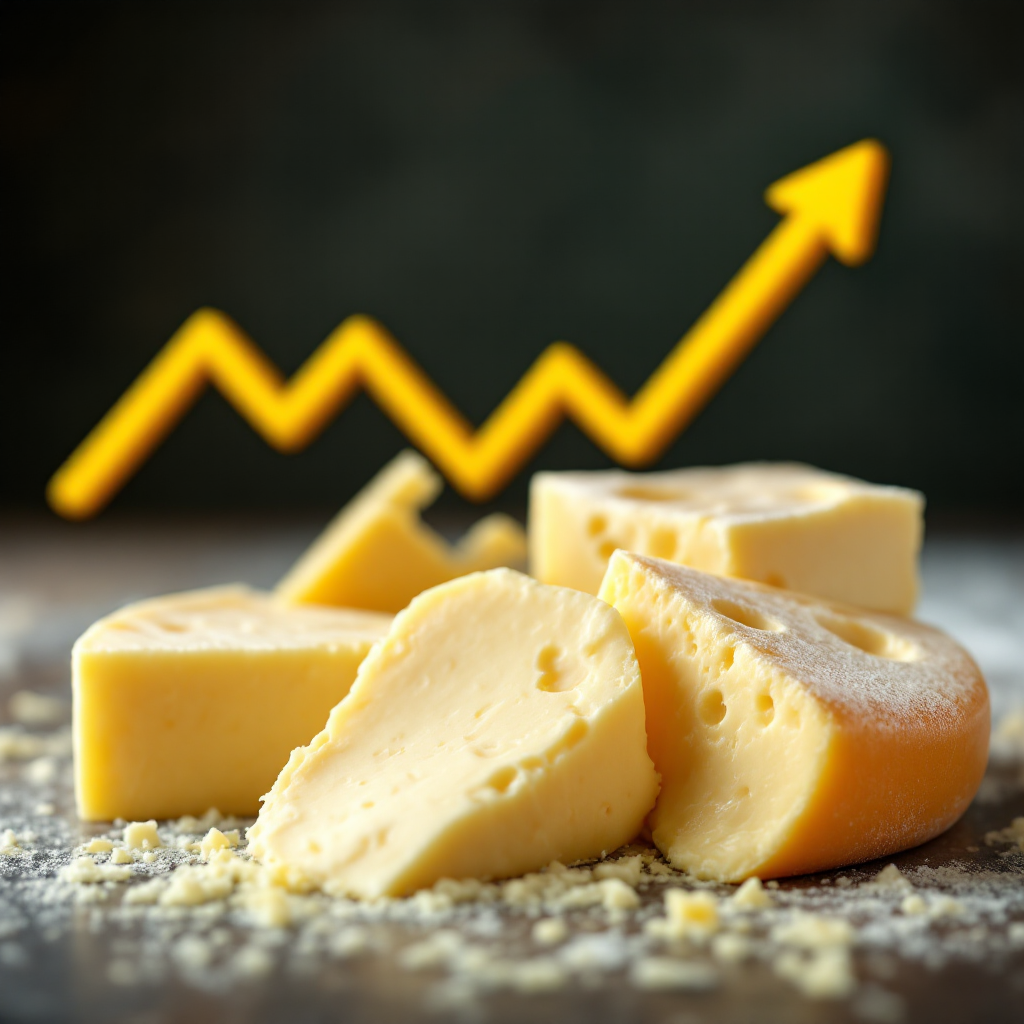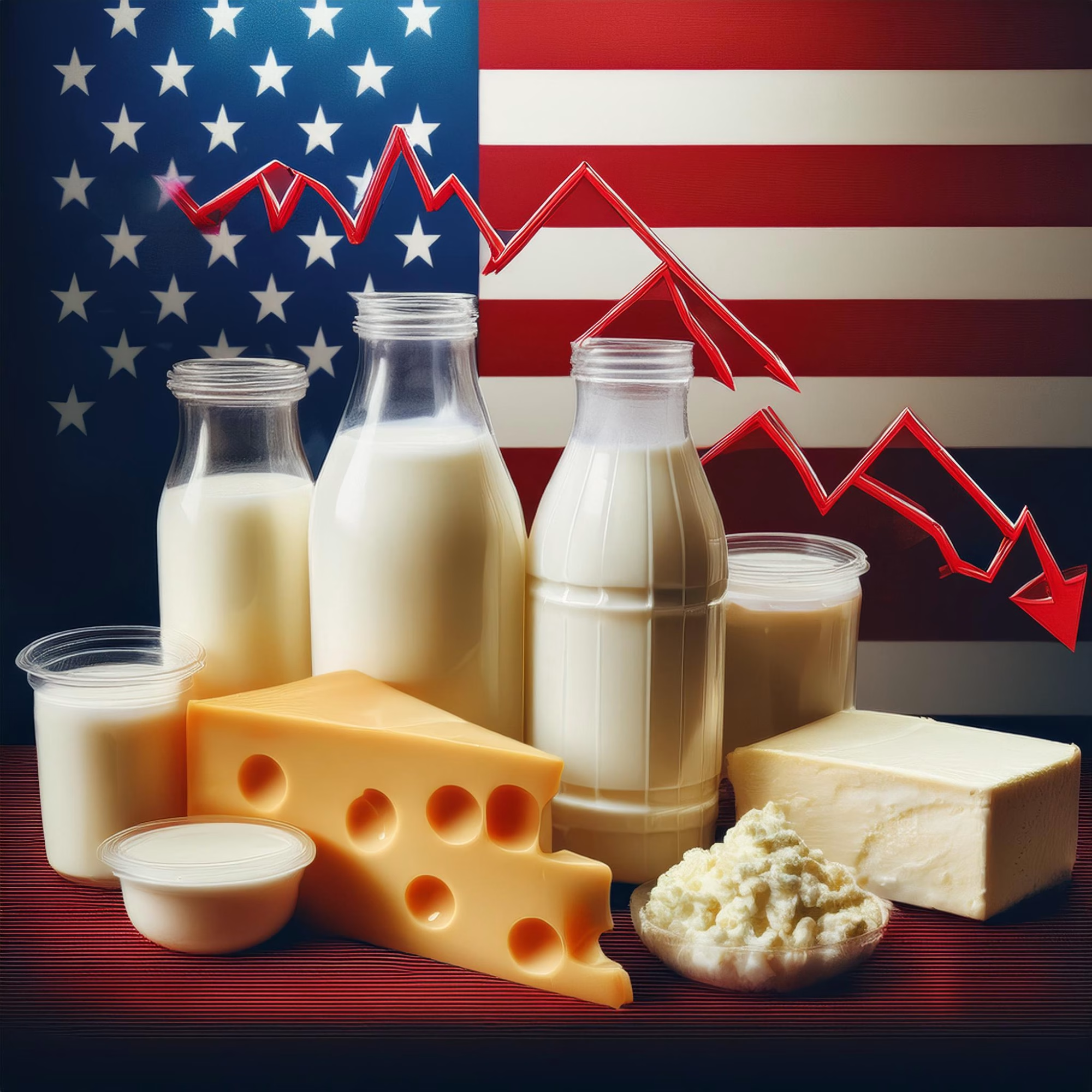Discover key trends as CME cheese and butter prices rise. Understand how U.S. production growth could affect your dairy strategies.
Summary:
The latest CME market report showcases a rally in Class III and cheese prices, driven by renewed buyer aggression and U.S. production gains, with the USDA’s October report detailing a 1% increase in cheese output and a 3.1% rise in butter production year-over-year. Market complexities like technical resistance levels and fluctuating whey prices prompt producers to reassess strategies, especially as U.S. cheese prices lag behind those in New Zealand and the EU. Dairy markets show bullish momentum, with block cheese at $1.70 per pound and butter prices increasing, paving the way for potential profit expansions. However, strategic hedging is necessary to balance pricing strategies and profit margins amid rising cheese prices, strong market dynamics, and holiday season-driven demand for butter now priced at $2.54.
Key Takeaways:
- Class III cheese and block cheese markets experience steady gains, indicating bullish sentiment despite seasonal demand fluctuations.
- The U.S. continues to produce more cheese and butter than previous years, driving domestic market prices up while still remaining competitive globally.
- Butter futures have risen significantly, with current market conditions suggesting a sustained demand around the $2.50 per pound mark.
- The USDA’s October Dairy Products report highlights an increase in overall cheese and butter output compared to last year, despite some sector-specific declines.
- Whey prices impact Class III contracts significantly, necessitating careful monitoring by producers, especially as the first quarter of 2025 approaches.
- The NFDM market faces challenges as global demand appears to stabilize, emphasizing the need for strategic positioning in the current pricing environment.
- U.S. dairy pricing remains more favorable compared to New Zealand and EU counterparts, providing competitive leverage in international markets.

Dairy markets are currently experiencing a bullish momentum, with cheese and butter prices on the rise. This unexpected pre-holiday market rally has certainly stirred things up. Block cheese has advanced to $1.70 per pound, and butter prices have also seen a significant increase. This rally presents both risks and opportunities, affecting pricing strategies, profit margins, supply chain decisions, and market forecasts. As these forces behind the numbers capture industry attention, it’s crucial to start strategizing for 2025, ensuring preparedness and proactivity in the face of these market dynamics.
| Product | Current Price (per pound) | Weekly Change | Comparison Index |
|---|---|---|---|
| Block Cheese | $1.70 | +3 cents | +7 cents week-to-date |
| Barrel Cheese | $1.6675 | +1.75 cents | +7 cents week-to-date |
| Spot Butter | $2.5400 | +1.75 cents | +5.5 cents from last week’s low |
| NDM | $1.3700 | -0.50 cent | Sideways price action |
Riding the Wave: CME Cheese and Butter Prices Climb Amid U.S. Production Surge
The recent pricing trends at CME exhibit a clear upward trajectory in cheese and butter, driven primarily by U.S. production dynamics and international market comparisons. Cheese markets are showing a continuous rally, with block cheese advancing to $1.70 per pound and barrel cheese climbing to $1.6675 per pound. Notably, both categories reflect a 7-cent increase this week, contributing to bullish sentiments in futures markets. This movement is juxtaposed against U.S. cheese prices, which are significantly lower than New Zealand and EU figures, priced at $2.13 and $2.28 per pound, respectively.
Butter pricing follows a similar ascent, now reaching $2.54 per pound, influenced by a robust production backdrop. The USDA’s recent dairy report indicates a 3.1% annual increase in butter output, revealing a comparative advantage over European and New Zealand markets, where butter prices are notably higher. These variances highlight the U.S.’s relative positioning in global markets, as the domestic increase in production aligns strategically with international price disparities, offering competitive advantages that bolster market resilience.
The Cheese Surge: Navigating Gains and Strategic Opportunities
The cheese market is currently undergoing significant shifts, particularly within the block and barrel cheese categories. Block cheese has climbed to $1.70 per pound, witnessing a 3-cent rise through multiple trades, while barrel cheese saw a 1.75-cent increase, settling at $1.6675. These seemingly modest increments have amplified the momentum in the futures market, particularly impacting Class III futures. Over recent sessions, January Class III futures have surged by $1.00/cwt, reflecting investor optimism fueled by these incremental gains. This surge in the cheese market presents a promising outlook, potentially leading to better returns for dairy producers.
These market shifts bear significant implications for dairy producers. The rising price of cheese indicates stronger market dynamics and potentially better returns. However, these gains bring with them the need for strategic hedging as there’s a delicate balance to maintain. For producers under-covered for the first quarter of 2025, the current rise offers an opportunity to secure favorable pricing floors. It’s crucial, however, to remain vigilant about whey prices, as any decline in whey, which plays a critical role in Class III pricing, could erode these advantages. Each penny drop in whey could translate to a 6-cent impact on Class III prices, underscoring the importance of monitoring these interconnected market components. While the present trajectory offers positive signals, producers must navigate these waters with a keen eye on volatility and fundamentals.
Butter Bounces Back: Market Dynamics and Growth Deceleration
The recent upswing in butter market prices reflects a nuanced amalgam of supply and demand dynamics. With spot butter rising 1.75 cents to close at $2.54, it is noteworthy that the butter futures have also shown appreciable gains, advancing 0.50 to 2.00 cents across contracts through July 2025. This upward movement suggests a robust reaction following some expected technical oversold conditions seen before Thanksgiving.
The driving force behind this price increase is the persistent demand during the holiday season, combined with a steady supply of cream, facilitating ample butter production. What’s compelling is the notable deceleration in butter output growth, shifting from a staggering 15.1% increase in August to a more moderate rise of 3.1% compared to last year. Despite this slowdown, the current production levels are sufficient to meet prevailing demand while maintaining price stability.
The second half of 2025 appears promising for a balanced trade, given the confidence in production capacity supported by available cream supplies. Yet, the market also benefits from targeted consumer interest around the $2.50 price point, adding a layer of demand elasticity that continues to underpin market strength.
USDA’s October Dairy Report: Navigating Production Shifts and Market Resilience
The USDA’s October Dairy Products report provides a comprehensive overview of the trends in cheese and butter production in the United States, revealing pivotal insights into market dynamics. Notably, total cheese production witnessed an incremental rise, reaching 1.226 billion pounds, marking a 1.0% increase compared to last year. This modest increase suggests a more robust output relative to the stagnation observed in September, signaling potential stabilization in demand despite underlying challenges.
Conversely, the production of U.S. Cheddar remains tepid, showing a 3.1% decline against the figures recorded in October 2023. This downturn in Cheddar production underscores a potential shift in consumer preference or market demand, challenging producers to optimize production levels without incurring surplus. Such strategic restraint aligns with maintaining balanced inventories amidst fluctuating demand.
In the butter sector, production expanded by 3.1%, totaling 167.5 million pounds. While this growth is a marked deceleration from the double-digit increases noted in August and September, it reflects the market’s ability to calibrate outputs effectively to avoid oversupply, thus supporting price levels. The deceleration suggests some caution among producers, yet the upward trend in butter production reinforces its consistent demand in the domestic market.
These production insights, grounded in the October Dairy Products report, highlight shifts in year-over-year production patterns and underline dairy producers’ nuanced adjustments to navigate current market demands and price signals. As the industry maneuvers through these fluctuations, strategic production decisions will be crucial in shaping future market resilience and pricing stability.
Strategic Advantage: U.S. Dairy’s Path to Global Leadership through Competitive Pricing
The current price of cheese in the U.S. is $1.67 per pound, significantly lower than in international markets such as New Zealand and the EU, where cheese fetches $2.13 and $2.28 per pound, respectively. This disparity presents a strategic opportunity for U.S. producers to expand their export reach. The more competitive pricing could make U.S. cheese an attractive option for international buyers seeking cost-effective imports.
Similarly, U.S. butter, priced at $2.52 per pound, is also competitively positioned in the global market compared to New Zealand’s $2.96 per pound and Europe’s far higher price of $3.80 per pound. Such pricing differentials present promising export prospects for U.S. butter producers, who can capitalize on these price advantages to penetrate foreign markets.
Lower U.S. price levels relative to international markets are beneficial for exports and could also influence domestic market dynamics. This pricing competitive edge may stimulate increased production as domestic suppliers aim to meet potential heightened demand at home and abroad. It may also lead to adjusting domestic supply chains to better cater to the export-oriented production strategy. For U.S. dairy farmers, aligning production with global pricing trends is crucial for sustaining competitiveness and leveraging new markets.
Whey and NFDM: Essential Components in Dairy Market Dynamics
The intricate web of the global dairy market is significantly influenced by the roles of whey and nonfat dry milk (NFDM). Recently, whey has shown resilience, maintaining its position above 70 cents despite a minor slip, a testament to its critical role in the Class III pricing structure. Given that every penny moves in whey correlates to a six-cent adjustment in Class III milk prices, its stability underpins the robustness seen in this sector despite broader market fluctuations.
On the production front, the October Dairy Products report indicated a notable downturn in dry whey production—down 12.3% from the previous year. This significant reduction in output, paired with a 33.1% decline in stocks from 2023, has likely contributed to the observed stability in whey pricing, supporting its market relevance even as other products like cheese advance [USDA Dairy Products report].
Conversely, NFDM’s market performance appears more precarious. Despite weaker production figures and growing inventories, NFDM prices remain around $1.40. Recently, the spot market saw NFDM edge down half a cent as supply pockets permeated the CME market, testing this price ceiling. Analysts suggest that the lack of aggressive global demand, amplified by global price competitiveness, may prevent NFDM from capitalizing on current price points [source].
The implications of these trends are profound for the dairy market. The robust price amidst constrained production indicates strong demand fundamentals for whey, offering producers a buffer against volatility in other dairy categories. Meanwhile, NFDM’s plateau suggests potential opportunities or risks contingent upon global demand or supply dynamics shifts. Therefore, Market participants must navigate these evolving landscapes strategically, balancing production with emerging market cues to effectively leverage these critical commodities.
Technical Terrain: Navigating Peaks and Valleys in Cheese and Butter Markets
The current landscape in the CME cheese and butter markets reveals key technical considerations that can significantly impact future price movements and trading strategies. Notably, the current market is facing resistance levels just above prevailing prices. This suggests that while a continued upward trajectory is possible, traders should exercise caution as price action could encounter difficulty sustaining momentum beyond these thresholds.
Technical patterns indicate the potential for a weekly reversal in nearby contracts, a development usually perceived as bullish despite lackluster current demand narratives. Such a reversal suggests that underlying strength supports current price rebounds. It could attract more buying interest if confirmed, further fueling upward price momentum.
Traders should watch these resistance points closely. Breaking through them could initiate a new price leg higher, indicating robust demand or supply dynamics that could alter market perceptions. On the other hand, failure to surpass these resistance levels could result in consolidation phases where prices stabilize, allowing for strategic reassessment.
Regarding trading strategies, prudent market participants might consider short-term positions to capitalize on these potential reversals and longer-term hedges to mitigate risk should prices reverse again or encounter sustained pressure. This multifaceted approach allows for flexibility, ensuring traders can efficiently adapt to evolving market dynamics.
The Bottom Line
The current landscape of the CME market indicates the rebound of cheese and butter prices and the intricate web of production dynamics influencing these shifts. As the U.S. continues to ramp up cheese and butter production, the pivotal role of strategic pricing relative to international markets cannot be overstated. Navigating the complexities of whey and NFDM further underscores the need for dairy professionals to remain vigilant and proactive in their market strategies.
Dairy farmers and industry stakeholders must monitor emerging market trends and assess how these could affect their operations. What strategies can you adopt to leverage this knowledge and navigate fluctuating market conditions? Can you implement innovative approaches to stay ahead of the competition despite shifting demand and production levels?
Engage with these questions, adapt your business strategies, and harness the insights from ongoing market reports. Staying informed with reports like these will ensure you are well-equipped to make informed decisions, enhancing your resilience and competitive edge in this dynamic industry.
Learn more:
- Why Cheese Prices Have Stabilized: Key Influencing Factors
- What’s Driving the Cheese Market? A Surge in Prices Explained
- Dairy Market Analysis: Milk Futures Hold Steady, Spot Cheese Gains, and Butter Slips
 Join the Revolution!
Join the Revolution!
Bullvine Daily is your essential e-zine for staying ahead in the dairy industry. With over 30,000 subscribers, we bring you the week’s top news, helping you manage tasks efficiently. Stay informed about milk production, tech adoption, and more, so you can concentrate on your dairy operations.







 Join the Revolution!
Join the Revolution!






